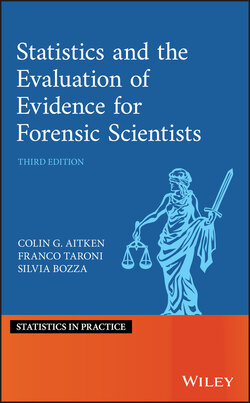Читать книгу Statistics and the Evaluation of Evidence for Forensic Scientists - Franco Taroni - Страница 16
1.1 Introduction
ОглавлениеThe purpose of this book is to discuss the statistical and probabilistic evaluation of scientific evidence for forensic scientists. A formal definition of evidence is given in Section 1.4. For the most part the evidence to be evaluated will be the so‐called transfer or (physical) trace evidence, but the general logic also applies to other types of evidence, such as digital, pattern, or testimonial evidence.
There is a well‐known principle in forensic science known as Locard's principle, which states that every contact leaves a trace (Locard 1920).
[ ] tantôt le malfaiteur a laissé sur les lieux les marques de son passage, tantôt, par une action inverse, il a emporté sur son corps ou sur ses vêtements, les indices de son séjour ou de son geste. (p. 139)
This is translated as (Inman and Rudin 2001)
[ ] either the wrong‐doer has left signs at the scene of the crime, or, on the other hand, has taken away with him – on his person (body) or clothes – indications of where he has been or what he has done. (p. 93)
The principle was reiterated using different words in Locard (1929). This has been translated by the same author in 1930. Locard (1930) wrote
For the microscopic debris that covers our clothes and bodies are the mute witnesses, sure and faithful, of all our movements and of all our encounters. (p. 276)
Transfer evidence and Locard's principle may be illustrated as follows. Suppose a person gains entry to a house by breaking a window and assaults the man of the house, during which assault blood is spilt by both victim and assailant. The criminal may leave traces of their presence at the crime scene in the form of bloodstains from the assault and fibres from his clothing. This evidence is said to be transferred from the criminal to the scene of the crime. The criminal may also take traces of the crime scene away with them. These could include bloodstains from the assault victim, fibres of their clothes, and fragments of glass from the broken window. Such evidence is said to be transferred to the criminal from the crime scene. A person of interest1 (PoI) is soon identified, at a time at which they will not have had the opportunity to change their clothing. The forensic scientists examining the PoI's clothing find similarities amongst all the different types of evidence: blood, fibres, and glass fragments. They wish to evaluate this evidence. It is hoped that this book will enable them so to do.
However, for evaluation, it is not only similarity that is important but also the rarity of the characteristics of interest. Hence, quantitative issues relating to the distribution of these characteristics will be discussed. However, there will also be discussion of qualitative issues such as the choice of a suitable population against which variability in the measurements of the characteristics of interest may be compared. Also, a brief history of statistical aspects of the evaluation of evidence is given in Chapter 3 .
